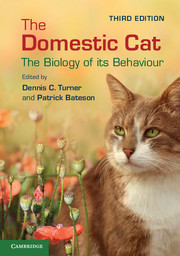Book contents
- Frontmatter
- Contents
- Contributors
- Abbreviations
- I Introduction
- II From Kitten- to Adulthood
- III Social Life and Ecology
- 5 Social organisation and behavioural ecology of free-ranging domestic cats
- 6 Social behaviour of domestic cats in the human home
- IV Cats and People
- V Cat Breeding and Cat Welfare
- VI The Future
- References
- Index
5 - Social organisation and behavioural ecology of free-ranging domestic cats
Published online by Cambridge University Press: 05 December 2013
- Frontmatter
- Contents
- Contributors
- Abbreviations
- I Introduction
- II From Kitten- to Adulthood
- III Social Life and Ecology
- 5 Social organisation and behavioural ecology of free-ranging domestic cats
- 6 Social behaviour of domestic cats in the human home
- IV Cats and People
- V Cat Breeding and Cat Welfare
- VI The Future
- References
- Index
Summary
Introduction
This chapter reflects an amazing ‘success story’, the story of a predator species, the domestic cat, which has more or less conquered the world within a few thousand years – partly with the help of humans, but mostly because of its amazing flexibility. It is not a new story and therefore easy to summarise. The summary is based upon three chapters in the second edition of this book, namely Macdonald et al. (2000), Liberg et al. (2000), and Fitzgerald and Turner (2000), but of course updated with later findings. Nor is that success story without ecological consequences which continue to fire the debate between cat friends and cat foes – or at least cat lovers and conservationists. Both sides of this debate should view the evidence before making hasty judgements.
Solitary life versus group-living: a question of resource availability
The domestic cat as a species and quite possibly as an individual shows amazing flexibility in its sociality toward conspecifics. Its ancestor, the North African wildcat, F. s. libyca, was (and is) indeed a solitary, territorial species, which presumably made use of the rodent populations concentrated in and around grain storage facilities of early farming settlements (see Chapter 7). As the likely story goes, this was beneficial to the farmers and they began provisioning the ‘wild’ cats with extra food, their home ranges became concentrated – and overlapping – around these human settlements and storage facilities, representing the first step toward domestication. The Resource Dispersion Hypothesis proposes that the dispersion of resources may be such that the smallest territory providing adequate security for the primary social unit (mother and offspring) may also support additional group members (Macdonald et al., 2000).
- Type
- Chapter
- Information
- The Domestic CatThe Biology of its Behaviour, pp. 63 - 70Publisher: Cambridge University PressPrint publication year: 2013
- 3
- Cited by

